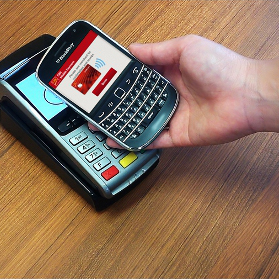Near Field Communications (NFC) sure is getting a lot of attention this week with the announcement of Apple Pay. In fact, the industry – Inside BlackBerry included – has been writing about it for years. NFC already exists in a large number of mobile devices we encounter today, and has for some time. It’s been built into BlackBerry devices since 2011 (more on that later), but it’s important to realize what it is and understand its potential in day-to-day life. It can do so much more than replace a wallet (although it’s actually been doing that for some time as well).
NFC is a short-range wireless technology designed for easy data, content and information sharing without having to physically connect two devices. In regular terms, you can wave, swipe, hover, bump or rub two NFC-enabled devices together to transfer information. Whether you’re setting up a connection in a car or pairing smartphones via Bluetooth to share a document or photo, NFC is designed to make it simple and easy. First introduced late 2010, BlackBerry has included NFC in our devices since the BlackBerry 7 OS smartphones back in 2011.
My first experience with NFC actually came years ago, when I was in the physical security industry. In an ID badge-controlled corporate office, the IT manager had programmed the badge functionality INTO the BlackBerry 7 devices. This allowed executives and employees to move throughout the buildings and floors of the company by tapping their NFC-enabled BlackBerry phones rather than an ID badge. Even a few years ago, this was an impressive acknowledgment that the smartphone would become the center of your computing world, and to the trusted security of the BlackBerry ecosystem.
Understanding what NFC is only makes up part of the equation. Its impact on daily mobile interaction makes up the rest.
NFC also allows us to emulate cards. Eventually, we could store all of our card data on our smartphones, eliminating the need for a wallet. This includes:
- Ticketing: Gaining access to events and shows
- Travel and transport: Plane, train, subway and bus tickets
- Payments: Using NFC to pay for items, instead of using a traditional credit or debit card
- Access: Using NFC for a security access keycard
- Identification: ID cards could be stored on a smartphone and displayed using NFC technology
But as I said before, NFC does more than replace your wallet. NFC allows:
- Sharing: Share electronic business cards, photos, files or data with other people with just a tap.
- BBM Contacts: Add contacts by bumping devices to connect.
- Pairing: Pair with Bluetooth devices or a router with ease.
- Smart Tags: Automate common tasks like launching an app by tapping certain things (for example, the BlackBerry® Travel app when tapping the NFC tag on their suitcase or tapping an NFC tag beside their bed to set their alarm).
- Checking in: Use Foursquare to check in at a venue simply by waving your device.
- Experience: Expand your reading with NFC-enabled books.
With NFC, the possibilities are endless. Soon we will be able to do away with everything weighing down pockets and purses. We’ll be able to connect and share through a wave, swipe, hover or bump, all thanks to our smartphones.
